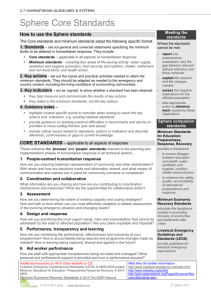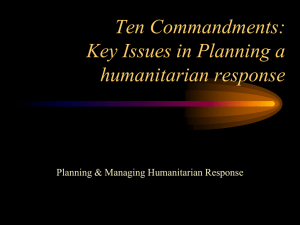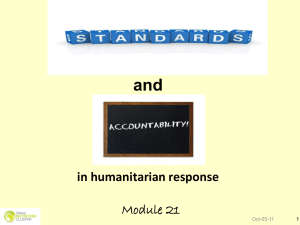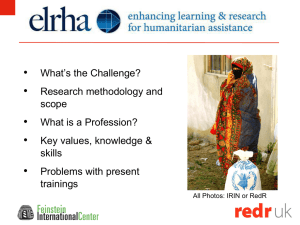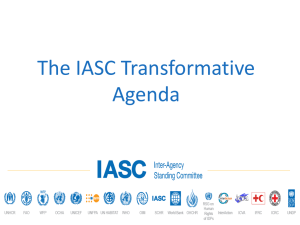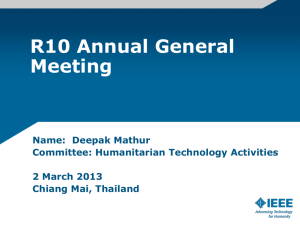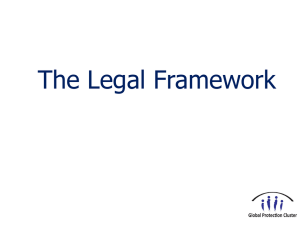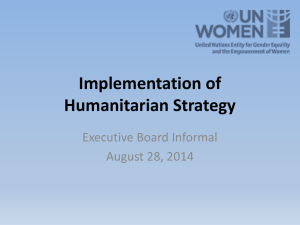Humanitarian Challenges today
advertisement
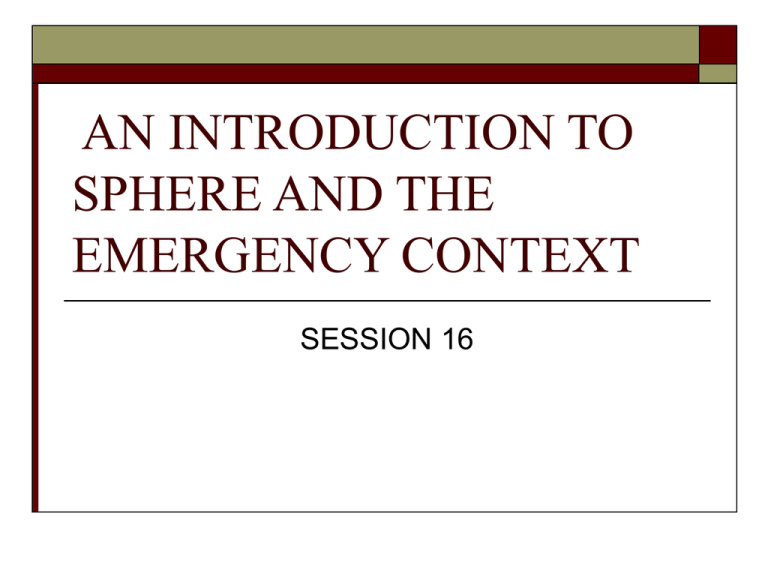
AN INTRODUCTION TO SPHERE AND THE EMERGENCY CONTEXT SESSION 16 Objectives By the end of the lesson, the learner should Have a basic understanding of Sphere Be able to define the fundamental principles of the Humanitarian Charter Distinguish Minimum standards from key indicators and guidance notes. Humanitarian Challenges Today The ever-increasing complexity of disaster response An increasing number of disasters An increasing number of humanitarian actors that define success in different ways, depending on who they are accountable to. What is Sphere Project The Sphere Project was created in response to this need for change - as an open and collaborative initiative to improve the quality and accountability of disaster response. It was conceived with the aim of promoting humanitarian action in an effective and accountable way. The Sphere Project can be viewed as a process that has: Argued for the universal right of all disasteraffected people to humanitarian assistance Achieved NGO agreement on core principles and actions Collected minimum programming standards for disasters from past lessons and experience Achieved consensus on technical standards and indicators The Sphere Consultation Process 1997: Initial consultation among 4000 people 2000: Sphere handbook launched. 2004: Revised edition of Sphere handbook launched To-date, 80 countries and 400 organizations have signed up. Outputs of The Sphere Project Sphere handbook is the main output. It outlines The universal right of all disaster affected people to humanitarian assistance Minimum programming standards and key indicators for disasters NGO agreement on core principles and actions Quality of and accountability in humanitarian work The Sphere Handbook Comprises of The Humanitarian chapter The Common Standards to all sectors The Technical Chapters. All these constitute Minimum Standards Key Indicators Guidance notes Why is the Sphere Handbook Needed NGO concern with quality and accountability Historic practice is no longer sufficient i.e. Increasing complexity of disasters Numbers of disasters increasing Changing nature of humanitarian community and increasing diversity Increasing number of actors with different measures of success Post-Rwanda 1994 Multi-donor evaluation ‘Unnecessary deaths’ The Humanitarian Charter: Provides some critical reflection on the common values and principles of the humanitarian community Contains a commitment to promote the observance of fundamental humanitarian principles and an appreciation of the ethical obligations of humanitarians and their organizations. This reflects A belief in the principle of humanity The primacy of the humanitarian imperative The idea that our actions should be governed by that imperative The Humanitarian Charter also Clarifies roles and responsibilities of various actors as described in international law: e.g. Outlines commitment to achieving defined levels through the minimum standards based on the right to life with dignity Acknowledges that the fundamental accountability of humanitarian actors is to those people we seek to assist. The HC Fundamental Principles Right to life with Dignity - based on the international Human Rights Law The distinction between combatants and noncombatants - based on the Geneva Conventions The Principle of non-refoulement – based on the international refugee law Exercise A brief review of the ‘The Humanitarian Charter’… handout Humanitarian Charter - Conclusion The humanitarian charter provides the framework to convert the appreciation of rights into action – and hence Minimum standards: Key indicators Guidance notes The Common Standards This chapter follows the ‘HC’ in the handbook These are Eight core ‘process and people’ standards that are relevant to each of the technical chapters that follow These standards outline common processes, such as assessments, response, targeting, monitoring and evaluation. There are also standards for working with people, including participation and aid worker competencies. Common Standard 1&2 The disaster affected population participated in the assessment, design, implementation, monitoring & evaluation of the assistance program Assessments provide an understanding of the disaster situation & a clear analysis of threats to life, dignity, health & livelihoods to determine, in consultation with the relevant authorities, whether an external response is required and if so, the nature of the response. Common Standard 7&8 No.7. Aid workers possess appropriate qualifications, attitudes and experience to plan and implement appropriate effective programmes No. 8. Aid workers receive supervision and support to ensure effective implementation of humanitarian assistance programme. Exercise on common Stds. Review 2 key indicators under common standard No. 8 i.e. page 41 The Technical Chapters There is general consensus that the following 4 Sectors are most crucial for the survival of disaster affected victims Water supply, sanitation and hygiene promotion Food security, nutrition and food aid Shelter, settlement and non-food items Health services Technical chapters Cont. In each technical chapter, tools are provided in the form of Minimum Standards and Key Indicators. Minimum Stds & Key Indicators Minimum Standards are universal goals that represent some of the components of a life with dignity Key indicators help agencies measure whether or not a standard is being met in practical, observable ways. There are various types of indicator in the handbook, primarily qualitative and quantitative. Indicators Indicators are tools used to measure: Outputs, outcomes& impacts of our programs and the processes used Using measurable indicators to quantify and qualify results is a key element in determining what has been achieved in a disaster response operation. Indicators: Facilitate program design Help to establish a clear record of the logic behind a program Provide a means of measuring quality Present opportunities for collaborative and transparent projects Guidance Notes These are specific points to consider when applying the standards & indicators in diff. situations, guidance on tackling practical difficulties, and advice on priority issues. They may also include critical issues relating to the standards or indicators, and describe dilemmas, controversies or gaps in current knowledge. Exercise Review the handouts on ‘Minimum Stds’ & Key indicators for Assessment & Analysis of Food security and Nutrition. Application of Sphere As a reference for every stage of the disaster response project cycle e.g. assessment ques, benchmarks etc. As a technical reference tool The technical rationale – since it avoids bias and inconsistencies in individual NGO guidelines Opportunities to improve quality and performance An advocacy tool – for resources Objectives of the session By the end of the lesson, the learner should Have a basic understanding of Sphere Project (??) Be able to define the fundamental principles of the Humanitarian Charter (??) Distinguish Minimum standards from key indicators and guidance notes. (??)
